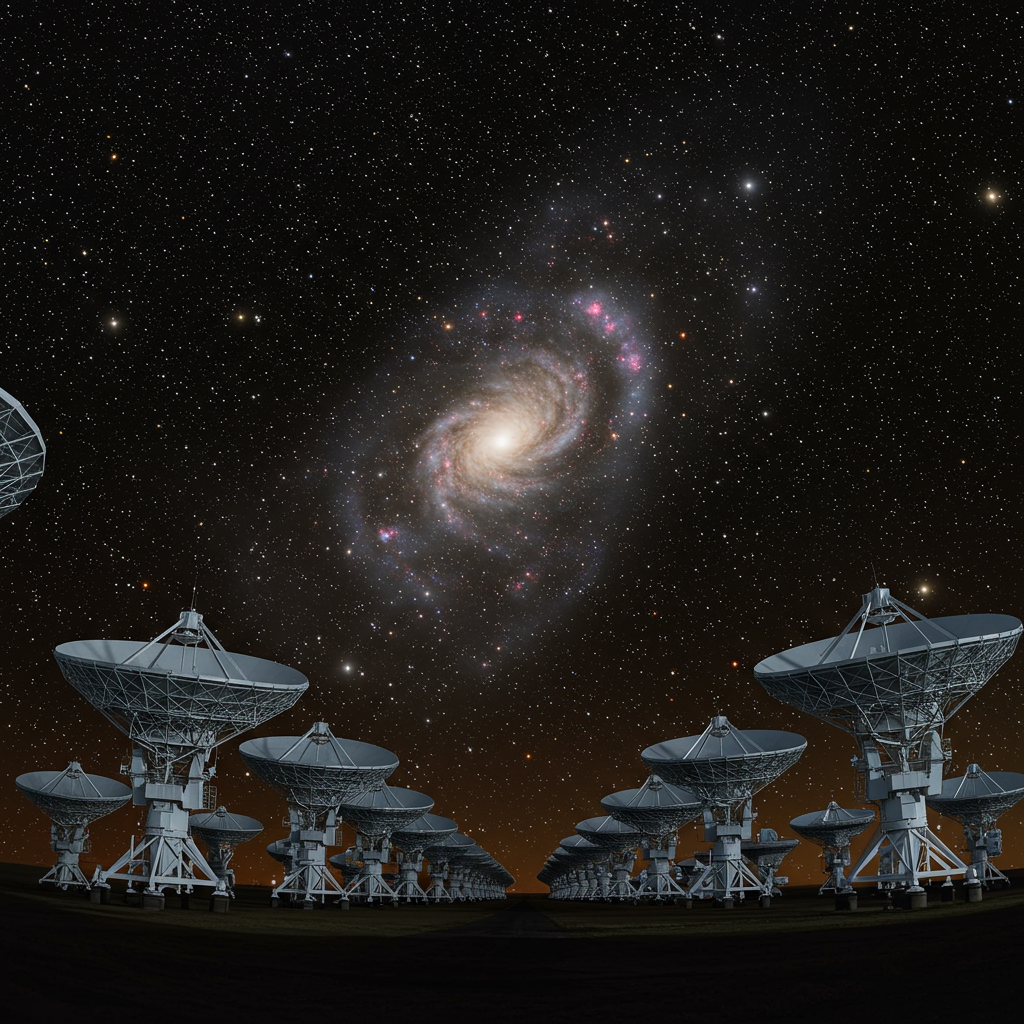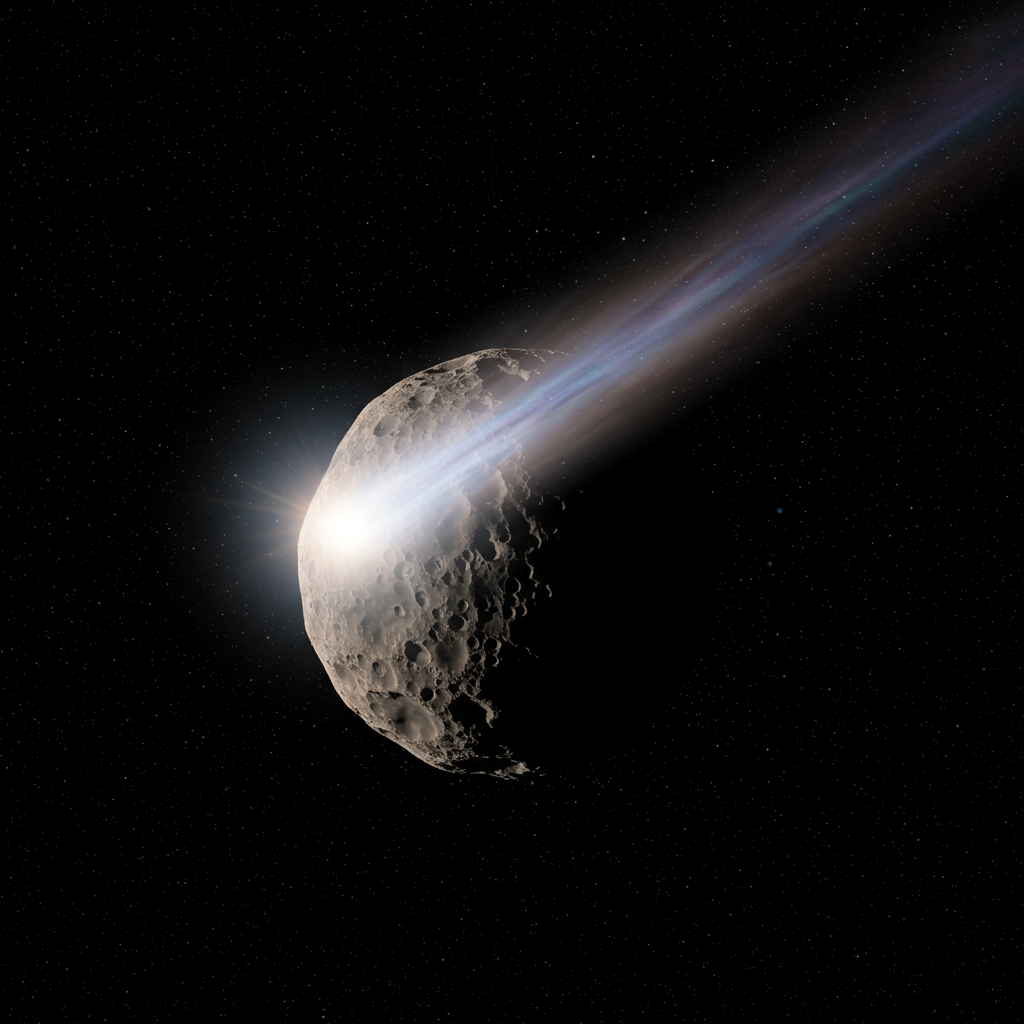Far beyond our solar system, in a remote cosmic neighborhood 10 billion light-years away, astronomers have stumbled upon an extraordinary phenomenon. Using a massive radio telescope network, scientists detected a faint but unmistakable glow of ancient radio energy emanating from a distant galaxy cluster. This diffuse signal comes from a structure known as a “mini-halo,” a vast cloud of high-energy particles surrounding the cluster’s core.
The discovery is not just a distant observation; it’s a direct window into the early universe. Because the cluster, designated SpARCS1049, is so incredibly far away, the radio waves we are detecting today began their journey approximately 10 billion years ago. At that time, the universe was less than a third of its current age, only about 3.8 billion years old. Finding evidence of such powerful energetic processes active during this youthful cosmic epoch is rewriting our understanding of how galaxy clusters, the largest structures in the cosmos, form and evolve. As one of the researchers put it, it’s like finding a vast cosmic ocean teeming with high-energy activity where we didn’t expect it.
Uncovering a Distant Cosmic Structure
Mini-halos are essentially large regions of diffuse radio emission found near the centers of some galaxy clusters. Unlike the brighter, more turbulent “radio halos” that can fill entire clusters undergoing major mergers, mini-halos are typically smaller, often located around the brightest central galaxy. They are powered by clouds of energetic charged particles, primarily ultra-relativistic electrons, that spiral within magnetic fields permeating the space between galaxies. This spiraling motion causes the electrons to emit synchrotron radiation, which we observe as faint radio waves.
Detecting these diffuse radio signals is incredibly challenging, especially across vast cosmic distances. The farther away an object is, the weaker and harder its signal is to pick out from background noise. Until this groundbreaking study, astronomers had only been able to confirm the existence of radio mini-halos within a few billion light-years of Earth. The detection of the mini-halo around SpARCS1049 at 10 billion light-years effectively doubles the distance record for observing such a structure. This specific mini-halo is immense, spanning over a million light-years across, making it more than 15 times wider than our own Milky Way galaxy. Its detection confirms that magnetic fields and energetic particles permeate the space between galaxies even in clusters from the early universe.
The team relied on the exceptional sensitivity of the Low Frequency Array (LOFAR) to make this discovery. LOFAR is a unique radio telescope network comprising 100,000 antennas spread across eight European countries, connected by high-speed fiber optics. This configuration allows LOFAR to function as a single, massive telescope capable of detecting faint radio signals that traditional telescopes might miss. By meticulously sifting through LOFAR’s data on the SpARCS1049 cluster, researchers identified the subtle, widespread radio glow surrounding the cluster core – a signature consistent with a mini-halo. Crucially, this signal wasn’t coming from individual galaxies but from the vast intergalactic space within the cluster.
What Powers These Ancient Radio Halos?
The existence of such an energetic mini-halo in the early universe presents astronomers with a significant puzzle: what mechanisms could generate and sustain these high-energy particles across millions of light-years for billions of years? Two primary theories are currently being explored.
One leading possibility points to the supermassive black holes located at the centers of the largest galaxies within the cluster. Many of these colossal black holes are known to be active, periodically ejecting powerful jets of high-energy particles into surrounding space. These jets could potentially inject the energy required to create and sustain the mini-halo. However, a major question remains: how do these particles travel such immense distances from the black hole source and maintain enough energy to contribute to the diffuse radio glow without significant energy loss?
The second proposed explanation involves cosmic particle collisions. The hot gas filling the space between galaxies in a cluster contains numerous charged particles, including high-speed protons and other atomic nuclei known as cosmic rays. According to this theory, when these cosmic rays collide at near-light speeds within the dense intracluster medium, they can break apart. These collisions produce secondary particles, including the relativistic electrons responsible for the observed radio emission. This mechanism could potentially power mini-halos over long periods wherever the hot gas is sufficiently dense, potentially without needing continuous input from black holes.
Determining which of these processes, or perhaps a combination of both, is dominant in powering these early mini-halos is crucial. It impacts our models of how black holes influence their environments (known as feedback) and how energy is distributed throughout galaxy clusters across cosmic time. The finding strongly suggests that these energetic particles and the processes creating them were actively shaping galaxy clusters much earlier than previously understood. It’s astonishing to find such a strong signal originating from so far away, confirming the dynamic nature of the young cosmos.
Implications for Cosmic Evolution
The detection of this record-breaking mini-halo in SpARCS1049 offers a rare and valuable glimpse into the physical conditions inside galaxy clusters shortly after their formation. It not only pushes back the timeline for the existence of widespread high-energy particle environments but also provides observational data to test theories about the origins of these particles. The evidence suggests that processes linked to black hole activity and/or high-energy particle physics were enriching galaxy cluster environments much earlier than expected.
Understanding the source and behavior of these energetic particles has broader implications. For instance, these particles can influence other astrophysical processes, such as star formation within the cluster’s galaxies. Their energy and pressure can interact with the hot gas, potentially preventing it from cooling and collapsing to form new stars. They also interact with magnetic fields, which themselves are poorly understood on such vast cosmic scales. This discovery provides a unique opportunity to study how these fields behave and their role in shaping the largest structures in the universe.
While this detection is a major step, many questions remain unanswered. Precisely how do black holes distribute energy so widely? How do particles maintain energy for billions of years? What is the exact role of magnetic fields in containing or transporting these particles? Scientists are only just beginning to scratch the surface of how truly energetic the early universe was.
The Future of Exploring Ancient Cosmic Energy
Future telescopes promise to shed more light on these cosmic mysteries. The upcoming Square Kilometre Array (SKA) observatory, currently under development, will be the world’s largest radio telescope, boasting significantly higher sensitivity and resolution than LOFAR. With over 131,000 antennas planned, SKA will be capable of detecting even fainter radio signals from the distant universe.
SKA will enable astronomers to map distant mini-halos in much greater detail. This enhanced capability will allow for more precise studies of their size, shape, and radio spectrum – how their brightness changes with frequency. Analyzing the radio spectrum can provide crucial clues about the age, energy levels, and acceleration mechanisms of the electrons powering the halo, helping researchers differentiate between the black hole and particle collision scenarios. SKA may even be sensitive enough to detect potential “flickering” in halo emissions as central black holes undergo active phases, providing direct evidence for their contribution.
The discovery of the million-light-year-wide radio mini-halo around SpARCS1049, dating back to a time when the universe was less than 4 billion years old, underscores the dynamic and energetic nature of the early cosmos. It provides compelling evidence that high-energy processes were actively shaping the evolution of galaxy clusters almost from their inception, setting the stage for exciting future discoveries with next-generation instruments.
Frequently Asked Questions
What is the ‘mini-halo’ discovered 10 billion light-years away?
The ‘mini-halo’ discovered around the galaxy cluster SpARCS1049 is a vast cloud of high-energy charged particles, primarily relativistic electrons, and magnetic fields located in the space between galaxies near the cluster’s center. These particles emit faint radio waves, making the structure detectable by powerful radio telescopes like LOFAR. It spans over a million light-years across and is the most distant radio mini-halo ever observed.
Why is finding this mini-halo 10 billion light-years away so significant?
The significance lies in its extreme distance. Finding a mini-halo 10 billion light-years away means we are seeing it as it was 10 billion years ago, when the universe was only about 3.8 billion years old. This pushes back the known timeline for when widespread, high-energy particle environments existed in galaxy clusters by billions of years, suggesting that these powerful processes were active much earlier in cosmic history than previously thought.
What are the leading theories for how the mini-halo particles get their energy?
Astronomers propose two main theories. One suggests that supermassive black holes at the centers of cluster galaxies launch powerful jets of high-energy particles. The second theory posits that collisions between high-speed cosmic rays within the cluster’s hot gas create the energetic particles. Both mechanisms could potentially power the mini-halo, but scientists are still working to determine which process is dominant, especially given the halo’s immense size and age.




